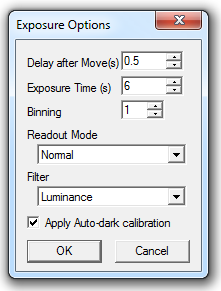Make sure the Telescope is synchronized on the sky so that the Right Ascension and Declination matches the telescope position. Make sure the camera is focused, and take an image of the star field in the area.
Select the Telescope tab.

Click the Setup Auto Exposure button, and configure a short (typically 10 seconds is sufficient) binned exposure. If there is some slop in your drive gears, you may want to set a brief Delay After Move. Click OK.

Click the Calibrate button, and set the Type to Auto.

You have two options: calibrate by moving the telescope, or calibrate using PinPoint Astrometry. If you have already set up to use PinPoint, this is the best option. Simply PinPoint solve the image, then click the Use PinPoint button.
If you do not want to use PinPoint, then make sure a reasonably bright (e.g. 5th magnitude), isolated star is visible in the image. Set Slew Distance to 1/8 to 1/4 of the field size for your camera (in most cases you can use 5-10 arc minutes). Click Calibrate.
The camera will take a picture, using the settings configured under the Setup Auto Exposure button. The telescope will then slew West, and a second picture will be taken. The telescope will then move back to the original position. The distance the star moved will be used to determine the scale and rotation angle of the camera view.
If you are using a German Equatorial mount, turn on the Use Scope Pier Flip check box; otherwise turn it off. Also turn off the Mirror check box unless your telescope has an odd number of mirrors.
Now you can rapidly center any object on the image. Simply right-click on it and select Point Telescope Here from the right-click menu. The telescope will slew a short distance to center the object.
If Expose After Slew is checked (recommended), a quick exposure will be taken after each centering movement, so you can see the results. For convenience, you may wish to right-click on the image and turn on Crosshairs.